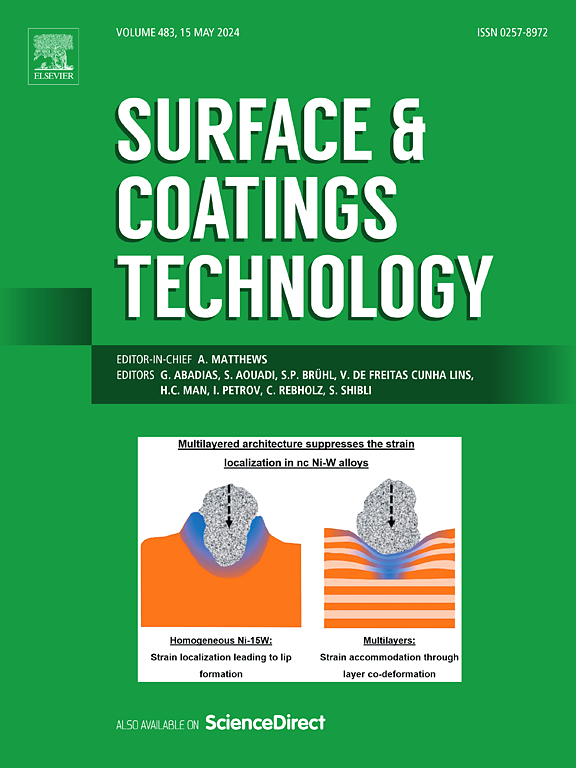粉煤灰制备坚固无氟超疏水涂料及其自洁、防冰、防腐性能
IF 5.3
2区 材料科学
Q1 MATERIALS SCIENCE, COATINGS & FILMS
引用次数: 0
摘要
近年来,超疏水涂层引起了研究人员的广泛关注。利用零成本固体废弃物作为结构组分制备超疏水涂料是未来发展的一个重要方向。本文以常见固体废弃物粉煤灰(FA)为主要材料,以环氧树脂(ER)和聚二甲基硅氧烷(PDMS)为主要成膜物质。采用喷涂法制备了多功能fa -超疏水涂层ER/FA@PDMS/SiO2。fa -超疏水涂层的水接触角(WCA)为156.4°±0.8°,水滑动角(WSA)为4.5°±0.1°。ER/FA底漆具有不规则多孔结构,PDMS/SiO2渗透到多孔结构中。多孔ER/FA涂层可以储存PDMS和SiO2, FA超疏水涂层内部和表面具有相似的粗糙结构和较低的表面能。fa -超疏水涂层具有很强的机械稳定性,在表面涂层被破坏后,涂层内部结构仍能保持优异的性能。FA-超疏水涂层的腐蚀电流密度约为9.392 × 10−7 A/cm2,比ER/FA涂层低一个数量级。在极冷条件下,fa -超疏水涂层可使结冰延迟约121.55%。这种简单、低成本的超疏水涂层在自清洁、防冰、防腐等方面具有很大的应用价值。本文章由计算机程序翻译,如有差异,请以英文原文为准。

Preparation of robust fluorine-free superhydrophobic coating using fly ash and its self-cleaning, anti-icing and anti-corrosion properties
Superhydrophobic coatings have attracted extensive interest from researchers in recent years. An important future development direction involves utilizing zero-cost solid waste materials as structural components to create superhydrophobic coatings. In this article, fly ash(FA), a common solid waste, was used as the main material, epoxy resin (ER) and polydimethylsiloxane (PDMS) were used as the main film-forming substances. A multifunctional FA-superhydrophobic coating ER/FA@PDMS/SiO2 was prepared by spraying method. FA-superhydrophobic coating exhibited a water contact angle (WCA) of 156.4° ± 0.8° and water sliding angle (WSA) of 4.5° ± 0.1°. ER/FA primer has an irregular porous structure, and the PDMS/SiO2 penetrate into the porous structure. The porous ER/FA coating can store PDMS and SiO2, and the FA superhydrophobic coating has similar rough structure and low surface energy inside and on the surface. FA-superhydrophobic coating have strong mechanical stability, after the surface coating is destroyed, the internal structure of the coating can still maintain excellent performance. The corrosion current density of FA-superhydrophobic coating is about 9.392 × 10−7 A/cm2, which is one order of magnitude lower than ER/FA coating. FA-superhydrophobic coating can delay icing by about 121.55 % under extremely cold conditions. This simple and low-cost superhydrophobic coating has great application value in self-cleaning, anti-icing and anti-corrosion.
求助全文
通过发布文献求助,成功后即可免费获取论文全文。
去求助
来源期刊

Surface & Coatings Technology
工程技术-材料科学:膜
CiteScore
10.00
自引率
11.10%
发文量
921
审稿时长
19 days
期刊介绍:
Surface and Coatings Technology is an international archival journal publishing scientific papers on significant developments in surface and interface engineering to modify and improve the surface properties of materials for protection in demanding contact conditions or aggressive environments, or for enhanced functional performance. Contributions range from original scientific articles concerned with fundamental and applied aspects of research or direct applications of metallic, inorganic, organic and composite coatings, to invited reviews of current technology in specific areas. Papers submitted to this journal are expected to be in line with the following aspects in processes, and properties/performance:
A. Processes: Physical and chemical vapour deposition techniques, thermal and plasma spraying, surface modification by directed energy techniques such as ion, electron and laser beams, thermo-chemical treatment, wet chemical and electrochemical processes such as plating, sol-gel coating, anodization, plasma electrolytic oxidation, etc., but excluding painting.
B. Properties/performance: friction performance, wear resistance (e.g., abrasion, erosion, fretting, etc), corrosion and oxidation resistance, thermal protection, diffusion resistance, hydrophilicity/hydrophobicity, and properties relevant to smart materials behaviour and enhanced multifunctional performance for environmental, energy and medical applications, but excluding device aspects.
 求助内容:
求助内容: 应助结果提醒方式:
应助结果提醒方式:


